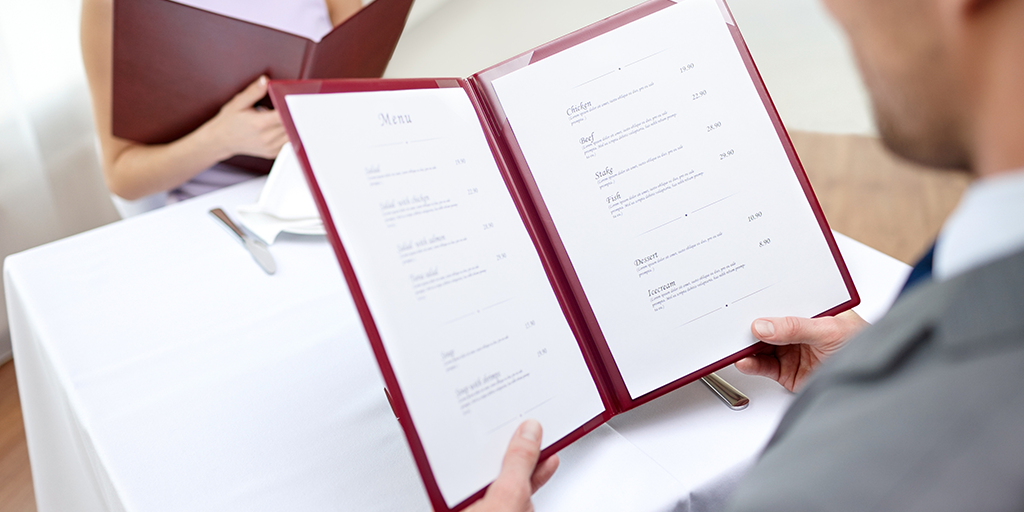The price. It’s often the first thing your guest will notice, and probably one of the (many) things keeping you up at night. How do you know it’s right? Does demand matter? Is just covering your costs enough? Does the price reflect the real value the customer is receiving from their meal?
All of these factors (demand, cost, and value) are important to consider when pricing out each item on your menu, whether you’re opening a restaurant for the first time or are a veteran restaurateur.
Pricing by demand
Frequently auditing your pricing or considering a dynamic model is one way to ensure that none of your menu items become a loss leader. Many restaurants only change their pricing once or twice a year, if that often. But compared with the pricing models of many other on-demand industries today, this infrequency is unusual.
Amazon.com, for example, changes pricing on millions of items every day, sometimes up to eight times on a single item in a single day. Certainly, this kind of flexibility in pricing is not practical for most restaurants, but taking a scalable lesson from their methods is still possible.
Knowing when demand for certain items peaks can help you make decisions about variable pricing. For example, do you price similar menu items differently at lunch versus dinner? Many restaurant operators do, and some have even gone so far as to set higher prices for times when reservations and seating hit maximum capacity.
If your tables all fill between 6 and 9 p.m., but you’re finding it difficult to drive revenue during the 4 to 6 p.m. stretch, a pricing adjustment between the two may encourage diners to fill your dining room at a more even pace. And it’s not unreasonable to charge more during higher volume periods. When traffic goes up, efficiency among your staff goes down. And when efficiency drops, costs — sometimes hidden — always rise.
Likewise, considering a different pricing model for online orders is another way to adjust your menu based on demand. And there’s no question it can be profitable. When Taco Bell introduced its app-based ordering system this spring, they saw a 20 percent increase in average total bill.
Much of this increase can be attributed to the relatively low-pressure environment of online ordering. With all the options for customization laid out to a diner and no server to add pressure to the sale, consumers will make more impulsive and taste-driven choices — and 50 cents here and there for extra onions or a side of sour cream quickly adds up to a significant increase in revenue.
But there’s also some value in reconsidering base pricing for a mobile or remote setting. High delivery fees can be off-putting to a consumer, but slightly higher prices across the board often go unnoticed. Just be careful about finding that right balance to meet demand — no one wants to alienate the customer.
Pricing by cost vs. value
More commonly, chefs and restaurant operators price their menu items on a “cost-plus” basis. That is, they calculate the cost to prepare a dish and add on the necessary dollar amount to cover its share of operational, staffing, small wares costs — and, of course, profit.
In the process of a menu audit, you may uncover that your pricing doesn’t sufficiently cover the cost to produce a dish. With a cost-based pricing model, your only recourse may be to increase price independent of what customers might be willing to pay, or cut costs associated with ingredients. While this method can help keep your restaurant in the black, it may also be undercutting potential revenue.
How do your current menu items measure up in price against similar dishes at other establishments in your area? The goal is to never be the most or least expensive option, but it’s often possible to move prices up steadily until they match the dish’s perceived worth in your market.
If you’re careful to assess your items’ values correctly, keeping reasonable comparisons in mind (e.g., similar atmosphere, style of service, type of ingredients), you can likely move your pricing up without alarming your customers. Just be careful to do all of your research independently! Comparing notes or otherwise colluding with other businesses to set pricing violates anti-trust business laws.
Ultimately, focusing on value over cost alone is more of an art than a science, but that doesn’t mean it’s arbitrary. Setting your menu pricing based on actual data on each dish’s perceived worth — not just what they cost to produce — will make for a better bottom line.
Remember: like discounting, underpricing can tarnish your brand just as easily as poor preparation or a bad customer service moment. Offering rewards to your guests not directly associated with the price of your menu items, however, can be a powerful incentive for a return visit — and doesn’t undercut your profits.
For more ideas on how to keep an eye on the quality and profitability of your brand, check out our look at the three things that drive great menu design:






